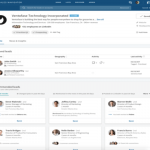bettering LinkedIn groups: steering for staff Managers
June 3, 2015
 In Can LinkedIn teams be Saved? I prompt enhancements Linkedin may make to make stronger the worth and restore the vitality of LinkedIn teams. irrespective of how many enhancements LinkedIn makes to the function, alternatively, the standard of LinkedIn teams is still highly dependent on the individuals who run them.
In Can LinkedIn teams be Saved? I prompt enhancements Linkedin may make to make stronger the worth and restore the vitality of LinkedIn teams. irrespective of how many enhancements LinkedIn makes to the function, alternatively, the standard of LinkedIn teams is still highly dependent on the individuals who run them.
here are my suggestions for each rookie and skilled managers of LinkedIn groups. this is not a basic how-to, in that I don’t describe the features and features and the way they may be able to be used. neither is it an exhaustive remedy. moderately, it’s a selective set of issues and proposals that focuses on particular components that tend to be the most important and/or trickiest components of efficient LinkedIn workforce administration.
word: although this article makes a speciality of LinkedIn teams particularly, the underlying principles and a number of the suggestions will also be utilized to other kinds of digital communities as neatly.
ahead of You Get began
as the owner and supervisor of a LinkedIn crew for nearly six years, i will be able to attest to how eating the accountability is. It’s extremely easy to start a bunch, but rising and sustaining one is a huge funding of time and energy. listed below are some questions and different considerations that can assist you appear – and assume – ahead of you jump:
- What do you wish to have to reach with the staff? What are your targets, for both individuals and firms (yours or others)?
- Is the crew truly vital? have you ever performed your due diligence to peer if there are different an identical groups that pursue the identical normal targets? Does your staff fulfill a novel area of interest that’s neither too large nor too slim?
- slightly than beginning a new team, it is usually better to search for dependent groups you could co-take care of or take over. this is particularly necessary for teams that characterize a model or organization (e.g., various alumni teams). For them, fairly than starting a competing “reliable” group, it might be higher to obtain and convert an “unofficial” one.
- Can the team appeal to a decent membership? larger is not necessarily better – if truth be told, I’ve end many of the greatest teams i have joined for the reason that extent of process was once just too great. however too small can also be complex too, especially in the event you’re the one active member. the ideal team is almost definitely moderately moderate in dimension (a couple of thousand, perhaps?), with a targeted membership and related engagement. despite the fact that there aren’t any ensures, at the outset that must seem potential.
- Are you willing/able to invest in constructing the staff? I’ve seen groups skyrocket in membership as the result of an lively recruitment campaign, but those groups also appear to get junked up pretty speedy. each amount and high quality topic. Do you could have the patience and self-discipline to pursue both?
- Are you keen/able to do the vital work to control the crew? Do you’ve a team who can lend a hand? team administration requires an extended-time period dedication and common engagement. is this workable?
our on-line world is full of what I seek advice from as “digital ghost cities” and “digital detritus,” neither of which is in an organization’s or brand’s lengthy-time period perfect interests. if you aren’t in a position to manage a LinkedIn crew (or some other digital platform for that topic) effectively, it’s better to now not even start down the trail. That said, it may be rewarding to capture the digital actual estate “simply in case,” and cling a “coming soon” sign. Then, when you’re ready, you won’t have to worry about the fact that anyone has already beat you to it.
Getting started
The LinkedIn group perform comprises many features and choices that enable just right group administration. listed here are some concerns and suggestions for the basic set-up tasks:
logo/title: make a choice a symbol and title that appropriately replicate the group’s focus. when you don’t have an professional logo, use a consultant image – just be sure you have a right to it! You also wish to you’ll want to won’t get in trouble using a widely known brand title with out permission. If there are a couple of similar staff and yours is the “reliable” one, you’ll want to embrace that in the identify. finally, remember to decide on your emblem/name correctly. LI frowns upon crew managers altering staff identities, they usually restrict the selection of occasions you can do it.
summary: You don’t have numerous text here, so that you want to be pithy. for the reason that summary is what’s listed within the teams directory and accessed when folks search on groups, you need to make it key phrase rich – content is extra vital than elegance! which you can provide an elegantly-labored, totally-fleshed out overview within the group’s Description.
get right of entry to: determining whether or not to permit people to sign up for robotically or wait for approval depends upon your goals and goals. for my part, i love to know who has joined my crew. I examine a lot from understanding the kinds of professionals who have opted into the crew: what parts of the world they arrive from, the businesses they work for, their practical areas, their positions… It’s like speedy market analysis! if you wish to track who’s joining your staff, a phrase of caution is so as about pre-approving other folks with sure email domains. for those who allow this option, folks will be delivered to the crew mechanically and you won’t have visibility to the entire new contributors who subscribe to.
members most effective: people have totally different points of view on Open versus contributors-most effective teams. The discussions in Open groups are effectively public and can get picked up by using search engines like google, which some people find sexy. Others prefer the exclusivity and quasi-privateness that participants-best teams provide. Make the choice that makes essentially the most experience to your team and its goals.
as soon as the crew is set up, you’ll also wish to make some decisions about workforce Settings, including:
Promotions and Jobs options. Enabling these options is an effective way to handle the posts that people would possibly believe junk or junk mail in the main information/dialogue feed, so i feel enabling them is a good suggestion.
Member posting permissions and restrictions. at first of a bunch, i might counsel having as few restrictions as that you can imagine. that you could at all times return and tighten things up, however why add some other management burden if it’s no longer in reality essential?
And here are some thoughts on a couple of more set-up tasks:
group Managers: whenever imaginable, have a few arrange, so that when anyone leaves the staff/organization that you may still proceed to manage the staff actively. Having multiple managers might also cut back the burdens of team administration via spreading the responsibility around.
staff ideas: ideas are a important part of effective group management. no longer handiest do they provide readability across the team’s focus and intent, they offer steerage for effective engagement through workforce participants. most significantly, they enable managers to average and manage shared content material with minimal conflict and minimal reputational impact. as far as I’m involved, every workforce should have respectable rules which might be truthful, simple for contributors to consider and agree to, and straightforward for managers to put in force.
Templates: LinkedIn means that you can set up templates for the next types of messages: Requests to enroll in, Welcome, Decline, and Decline-and-Block. At a minimum, you’ll want to arrange a Welcome message, and i strongly inspire managers to incorporate posting ideas in that message.
Subgroups: this is some other function that seemed like a good suggestion when it used to be rolled out, and one that some individuals strongly suggest, however in observe I haven’t seen it add so much value for a number of causes. usually conversing, except your workforce is going to be really huge and there are assorted subgroups on the way to be substantive in their very own proper, I wouldn’t pursue it. the advantages gained’t justify the hassle.
Ongoing administration
you can be shocked at how much effort it takes to set up a gaggle correctly, but your work has simply begun! i like to recommend that team managers revisit their arrange as a minimum once a quarter and assessment and revise crew knowledge, settings, principles, and templates as necessary. listed below are some additional concerns and proposals…
Recruiting/accepting new individuals. there are many things you are able to do to grow your teams. that you can motivate members to share the crew (as a standing replace, with specific groups, and/or with people both within and outside their LI networks). And you could initiate periodic recruitment campaigns during which a core workforce of managers/members invites folks to enroll in. if you happen to require approval for brand spanking new individuals, you should definitely continuously assessment and act on the requests to join (preferably when information of their becoming a member of will hit the news feeds of their connections at a time when they’re likely to see them).
Contributing content material. within the early days of a bunch, the house owners/managers are likely to be the main content material contributors and dialogue starters (which can be extra prone to be monologues). Be prepared for the “sounds of silence,” and don’t underestimate the importance of listening as a form of engagement. For longer than I care to remember, I was once the main voice in my LinkedIn workforce, however ultimately a core team of other people who ceaselessly share information items and interact in discussions developed. As with gardening, you need to be ready to seed and nurture the crew’s content to promote wholesome growth…
Moderating content material. Weeding is also critical to a bunch’s well being, but moderation is the bane of a bunch supervisor’s existence – regardless of how excellent the team is! Some managers wish to pre-average all content material, however I’m not a fan of that idea. As a gaggle manager I in finding it unnecessarily burdensome, and as a group participant I in finding it aggravating. however, it’s your prerogative as a group supervisor – do no matter works right for you and your staff.
in spite of whether you pre- or publish-reasonable content, you’ll need to screen the team’s task incessantly (day-to-day if imaginable) and act speedy to wash up/move inappropriate content material. Inappropriate postings are roughly like graffiti – the longer they sit down there, the more they seem like tolerated, and the more likely anyone else will interact in the identical behavior. As cited above, to verify your moderation actions are perceived as honest, you will have to create a collection of posting ideas and communicate these principles to participants by way of the Welcome message and other method (e.g., periodic announcements). And please make sure the principles make feel…
Connecting to Twitter. so far as i do know, I’m the only workforce supervisor who does this, but it’s a trick that’s worked smartly for our LinkedIn group, not just in terms of sharing content material, but additionally in the case of increasing engagement and membership in each locations. We tweet out all almost the entire information objects shared within the LinkedIn workforce by the use of @Denovati, attributing posts to folks the usage of their Twitter handle every time conceivable. using HootSuite, we schedule the posts to go out all through the week, which is a great way to regulate the duty.
announcements. I’ve viewed crew managers use the Announcement characteristic (restrict one per week) in a number of ways: to summarize the week’s activity, to supply different offers, to advertise sure types of activity, to remind individuals about crew principles, and more. thankfully, i have rarely seen workforce managers abuse this selection, and i inspire people to use it in ways that make sense with their groups.
Managing member activity and memberships. in case you have team individuals who persistently publish inappropriate content, or submit things to the flawed situation, that you could change their permissions so which you can pre-moderate all their content material. that you can also block all their content and/or remove them from the workforce. in lots of key respects, teams perform as dictatorships, and you should utilize the authority and energy your position gives you. That said…
despite the fact that staff managers should be disciplined, constant, and truthful, they must pursue their responsibilities with a mild contact. It’s necessary to supply a clear experience of purpose and center of attention, in addition to clear posting principles, however you shouldn’t make issues unnecessarily complicated. Many team managers can undermine their own goals through having set-up constructions which might be too much work for many team participants to concentrate to. less is most definitely more – it’s significantly better to keep things so simple as possible, and to chop individuals as much slack as imaginable.
Overmanaging a group can be onerous and time ingesting, so I’ve realized to let individuals be accountable for the quality of their posts themselves and to research from their errors on their own (extra about that within the subsequent article). That mentioned, when someone crosses a transparent line you’ve drawn within the sand, you shouldn’t hesitate to do no matter is important to maximise the quality of the crew’s content material. And don’t feel you wish to follow up or provide an explanation for your movements. I used to message rule violators about their infractions, but I’ve made up our minds that being proactive about that isn’t really a good use of time. if you happen to do decide to apply up, remember that to keep things pleasant and collegial – no want to be heavy-surpassed.
Calling It Quits
All good issues – however especially unhealthy issues – must come to an finish. there are a selection of the reason why folks and companies who’ve began groups will realize they wish to call it quits, including:
- bad match with targets/goals
- Low membership
- limited content sharing and/or engagement
- bad content high quality
- massive, unmanageable membership
- lack of ability to commit the time and power wanted to regulate the team successfully
a group proprietor/supervisor can merely delete a group, but when the staff is relatively massive and/or lively, it is usually better to seek out a new proprietor and transfer ownership to that particular person somewhat than disbanding the group. it could even be possible to seek out and assign new managers who can revitalize the workforce and repair what’s broken. All of these options are better than the choice – which I’ve viewed a couple of managers do – of merely leaving the crew to its personal devices. That’s when the graffiti and weeds and litter really take over…
Your ideas?
As all the time, I welcome your remarks. Do you believe my suggestions? What other tips would you make to LinkedIn staff managers?
Digital & Social Articles on trade 2 community
(150)













